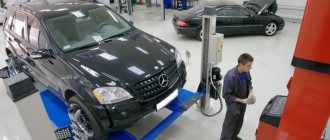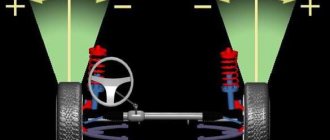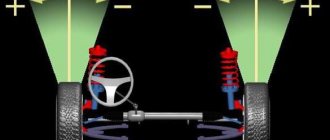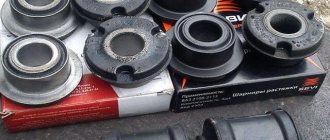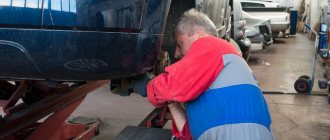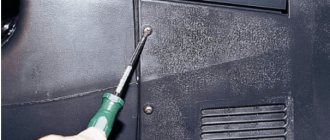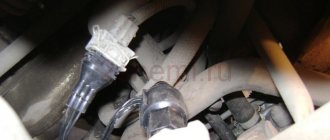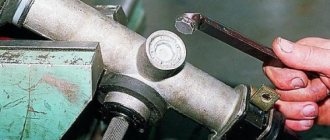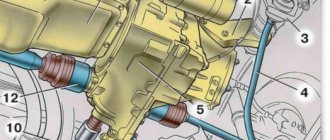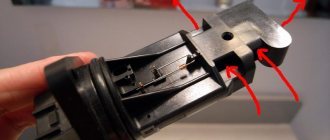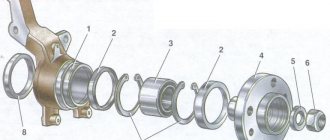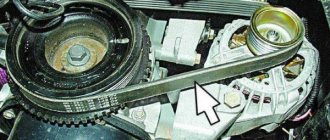Do-it-yourself wheel alignment on a VAZ 2112. Taxi Bolt
You can adjust the wheel alignment angles of your car with your own hands, using available tools and ordinary tools. In this material we will tell you how to do wheel alignment without the help of others at home, and what difficulties are encountered in most cases when adjusting wheel alignment angles.
Incorrect wheel alignment adjustment may be a prerequisite, for example, for rapid wear of tires, or for the fact that when driving in a straight line the car will steer to the left or to the right. At the end of this article you will find a video that carefully explains and shows everything you need to know about wheel alignment.
First, let's look at the theory: wheel alignment. What is this? What are the wheel alignment angles and how does the car’s behavior on the road depend on them? Wheel alignment. What is this anyway?
Destruction. This is the angle between the vertical and the plane of the wheel. It ensures reliable contact of the tire with the road (see picture above). Convergence. This is the angle between the direction of movement and the plane of rotation of the wheel. The stability of the car in corners and tire wear depend on it.
In rear-wheel drive vehicles, the wheels should be slightly pointed towards each other. this is called positive toe. When moving, they move apart and become parallel. For front-wheel drive. on the contrary, the toe should be negative (see diagram below).
Custer. this is the longitudinal inclination angle of the kingpin. This parameter very rarely needs to be adjusted, only on a newly assembled front suspension made from new parts, so we will NOT consider its adjustment.
Repairing the suspension or steering control (replacing the same shock absorbers or control joint) leads to a significant change in the mounting angles of the wheels. Everyday operation of the car also makes adjustments to these characteristics over time, so from time to time there is a need to adjust the wheel alignment.
It is ideal to adjust the wheel alignment twice a year, during seasonal tire changes. During this period of time, you will fall into a hole more than once or run over a curb, causing the chassis to become loose and the angles to change. Timely alignment adjustment will cost much less than a set of new tires.
In 1955, South American engineer Lee Hunter developed the first wheel alignment control panel. Sensors mounted on the wheels sent focused beams of light and accurately measured angles. That's why the shield was called optical. But already in 1969 it was connected to a computer, and in 1995, 3D technology was used for the first time to measure and adjust angles.
True, Russian car owners drove without any shields or computers. Using wrenches, calipers, a whine and a plumb line, they adjusted the camber and toe angles with their own hands. Note on how to adjust the wheel alignment yourself
Before you begin adjusting the camber and toe angles, you absolutely need to check the car's chassis. If repairs are needed, then doing a wheel alignment is stupid. Steering and suspension must be in perfect order.
Pay attention to three points on which the wheel alignment angles on a car very much depend: the serviceability of the chassis (more about diagnosing the car suspension) Tire pressure. Loading the car.
Before adjusting the wheel alignment, be sure to check the pressure in the tires and make sure that you have NOT accidentally left a couple of bags of potatoes or cement in the trunk :) As an example, we will describe how to do a wheel alignment with your own hands on a VAZ 2109 car.
Adjusting the camber angle of the wheels.
The camber angles are adjusted in the following order (We remind you that in our case the actions are described for a VAZ 2109 car):
Before adjusting the camber, the car must be parked on a level surface. We put two vertical marks along the diameter of the wheel rim with chalk. one on top, the other on bottom. We apply a cord with a plumb line to the wing, and along the marks with a ruler or caliper we measure the distance from the rim to the cord at the top mark, and then at the bottom.
The difference should be ± 3 mm. The rim may NOT be flawless, so it is better to roll the car, turn the wheel 90 °, and make 2 more vertical marks. Again we produce frozen.
Do the same on the second wheel and write down the result. Then turn the car 180° and again take measurements, write them down and compare them. Then remove the wheel and, using 2 19mm wrenches, loosen the two bolts securing the shock absorber strut bracket to the steering knuckle.
Move the steering knuckle with a wrench to 19 due to the eccentricity of the bolt head inward or outward to the required distance, thus achieving the desired camber angle. Tighten the bolts, put the wheel in place, lower the car and rock it a couple of times, pressing on the fender. Take measurements.
On rear-wheel drive cars, the camber angle should be within 1/3 mm, and on front-wheel drive cars, the usual range is 1 to 1 mm. Adjusting the wheel toe angle
To adjust the angle of convergence, it is most convenient to take measurements using a special telescopic ruler with a scale (look at the photo above). It is more convenient to work in a pit. The steering wheel should be in a straight-ahead position.
Before adjusting the toe, make one mark on the inside of the wheels with chalk on the left and right tires as close as possible to the rims. Having created a preparatory tension in the ruler, install it, resting its ends against the intended points so that its body does not touch the body parts and suspension. Shake the ruler a little, and on the moving scale combine “zero” with the fixed pointer.
Lock the scale. Carefully Roll the car forward so that the ruler together with the wheels moves backwards, but does not touch the suspension and body parts. Check the readings.
If on a VAZ 2109 the distance between the wheels at the rear is less than at the front, then the control rods need to be shortened, and if it is longer, then. lengthen
Using a 27 wrench, loosen the locknut on the control rods. Nuts with marks on the edges have a left-hand thread. Using a 24mm wrench, rotate the coupling to configure the length of the pull.
Don’t forget: Watch the horizontal position of the steering wheel spokes. Place the moving scale on the ruler to adjust the toe to “zero” and roll the car back. With readings from 1 to 1 mm, you can complete the adjustment of the toe angle.
Look in turn from the side of each front wheel to the alignment of each rear wheel. With the steering wheel spoke horizontal, you will simply see that there is either no displacement of both wheels to the left or to the right. If the displacement is noticeably obvious, then by unscrewing one rod and tightening the other by the same number of turns, correct the displacement.
READ What Benefits Removing the Catalyst from a Car
After adjusting the wheel alignment yourself, it’s worth thinking about which wheels to choose: stamped or cast? It is believed that cast wheels significantly reduce the load on the suspension, while stamped ones. more comfortable.
You can adjust the wheel alignment angles of your car with your own hands, using available tools and ordinary tools. In this material we will tell you how to do wheel alignment without the help of others at home, and what difficulties are encountered in most cases when adjusting wheel alignment angles.
Incorrect wheel alignment adjustment may be a prerequisite, for example, for rapid wear of tires, or for the fact that when driving in a straight line the car will steer to the left or to the right.
What should the installation angles be: negative and positive values?
Average value for a passenger car. either zero or slightly negative (i.e., the wheels should be slightly pointed outward with the bottom).
Possible setting to a positive value. from 0 to 4.5 degrees. In sports cars, a negative value of .5 to .5.5 degrees is used. This ensures the highest level of grip and increases cornering stability.
There are disadvantages to negative angles. So, when driving in a straight line, the inner edge of the tire will wear out faster, and instability is likely when accelerating and braking on a straight path. A good option is to set the indicator at 0.5 degrees.
Positive and negative destruction.
https://sjracing.ru/svoimi-rukami/sxod-razval-na-vaz-2110-svoimi-rukami-kak-sdelat-razval-sxozhdenie-svoimi-rukami-na-vaz-2110-video-chto-takoe- kaster-kogda-nuzhno-delat-i-kak-pravilno-vystavit-regulirovku-uglov-v.html
Front suspension of VAZ 2110, VAZ 2111, VAZ 2112
Front suspension designFront suspension device for VAZ 2110, VAZ 2111, VAZ 2112 |
Wheel alignment anglesAngles of installation of the front wheels of VAZ 2110, VAZ 2111, VAZ 2112 |
Spherical bearingRemoving and installing the ball joint VAZ 2110, VAZ 2111, VAZ 2112 |
Lever and suspension extensionRemoving and installing the lever and extension VAZ 2110, VAZ 2111, VAZ 2112 |
Disassembling and assembling the rackRemoval and installation of shock absorber strut VAZ 2110, VAZ 2111, VAZ 2112 |
It is quite possible to correct the alignment of a VAZ 2110 with your own hands, using simple devices and improvised means.
First of all, it is worth noting that replacing the steering joint or shock absorbers leads to a significant change in angles, which will subsequently require adjustment. As a rule, in most cases it is enough to adjust only two of these parameters: toe and camber angles. In addition, there is a third parameter, namely the longitudinal inclination angle of the kingpin, which needs adjustment much less frequently than others.
Diagnostics
So, in order to adjust the toe-in of the wheels, it is most convenient to take measurements using a special ruler, while it is most comfortable to work in the pit. In addition, do not forget to place the steering wheel strictly in the straight-ahead position. Before adjusting the wheel alignment of the VAZ 2110 with your own hands, you need to apply marks on the inside of the wheels; you can use chalk for this. After you create tension in the ruler, you need to install it, resting its two ends on the previously designated points. Then shake the ruler slightly, and then align the “zero” with the pointer.
Wheel alignment on VAZ 2110
Don't forget to fix the scale. After this, roll the car forward a little so that the ruler moves along with the wheels, but does not touch the suspension or body. Then you need to check the readings. It is quite possible to correct the wheel alignment of a VAZ 2110 with your own hands without having much experience.
Toe adjustment
So, if on a car the distance between the wheels located at the rear is less than at the front, then it is necessary to shorten the steering rods, and if it is greater, then, on the contrary, lengthen it. It is worth noting that such adjustments must be made after almost every repair of the vehicle chassis. Also, even if you haven't done any repairs, be sure to have your vehicle inspected at least every six months.
In order not to adjust the wheel alignment, it was not necessary to carry out the alignment after the repair; before disassembling the suspension, you need to mark absolutely all disconnected connections; if you don’t have chalk on hand, you can get by with paint or a chisel. In addition, you should count the number of revolutions while turning the ends out of the rods.
However, do-it-yourself wheel alignment of a VAZ 2110 is quite a common procedure that any experienced motorist can handle without much difficulty.
Thank you for attention.
Angle of longitudinal inclination of the axis of rotation
– the angle between the vertical and the line passing through the centers of rotation of the ball joint and the bearing of the telescopic strut support, in a plane parallel to the longitudinal axis of the vehicle. It helps stabilize the steered wheels in the direction of straight motion. This angle is adjusted by changing the number of shims on the extension ends. To decrease the angle, washers are added, and to increase it, they are removed. When installing/removing one washer, the angle changes by approximately 19″. Symptoms of deviation of the angle from the norm: the car pulls to the side when driving, different forces on the steering wheel in left and right turns, one-sided tread wear.
Wheel camber angle
– the angle between the plane of rotation of the wheel and the vertical. It promotes the correct position of the rolling wheel during suspension operation. The angle is adjusted by turning the top bolt securing the telescopic strut to the steering knuckle. If this angle deviates greatly from the norm, the vehicle may deviate from straight-line motion and cause one-sided wear of the tread.
Wheel alignment
– the angle between the plane of rotation of the wheel and the longitudinal axis of the car. Sometimes this angle is calculated by the difference in the distances between the edges of the rims, measured from the rear and front of the wheels at the level of their centers. Wheel toe ensures the correct position of the steered wheels at various vehicle speeds and turning angles. Toe is adjusted by rotating the adjusting rods with the tie rod ends loosened. Before adjustment, the steering rack is set to the middle position (steering wheel spokes are horizontal). Signs of toe deviation from the norm: severe saw-tooth wear of the tires in the transverse direction (even with small deviations), squealing tires when cornering, increased fuel consumption due to high rolling resistance of the front wheels (the vehicle's run-out is much less than expected). It is recommended to check and adjust the angles of the front wheels at a service station. The vehicle is placed on a horizontal platform and loaded in accordance with the manufacturer's recommendations. Checking and adjusting the angles on an unloaded vehicle is acceptable, but will give less accurate results. Before doing this, you should make sure that the tire pressure is normal, the tread wear on the left and right wheels is approximately the same, there is no play in the bearings and steering, the wheel rims are not deformed (radial runout - no more than 0.7 mm, axial runout - no more than 1 mm).
Checking the wheel alignment angles is mandatory if suspension parts that affect these angles have been replaced or repaired. Due to the fact that the installation angles of the front wheels are interconnected, first of all the caster angle of the turning axis is checked and adjusted, then the camber and, lastly, the toe-in. For a run-in vehicle in running order and with a payload of 320 kg (4 people) in the cabin and 40 kg of cargo in the trunk, the wheel alignment angles should be within the following limits.
Wheel alignment. what it is?
First, let's look at the theory: wheel alignment. What is this? What are the wheel alignment angles, and how does the car’s behavior on the road depend on them?
Destruction. This is the angle between the vertical and the plane of the wheel. It ensures reliable contact of the tire with the road (see picture above).
Convergence. This is the angle between the direction of movement and the plane of rotation of the wheel. The stability of the car in corners and tire wear depend on it.
- In rear-wheel drive vehicles, the wheels should be slightly pointed towards each other. this is called positive toe. When moving, they move apart and become parallel.
- In front-wheel drive. on the contrary, the toe should be negative (see diagram below).
Custer. this is the longitudinal inclination angle of the kingpin. This parameter very rarely needs to be adjusted, only on a newly assembled front suspension made from new parts, so we will NOT consider its adjustment.
Repairing the suspension or steering control (replacing the same shock absorbers or control joint) leads to a significant change in the mounting angles of the wheels. Everyday operation of the car also makes adjustments to these characteristics over time, so from time to time there is a need to adjust the wheel alignment.
It is ideal to adjust the wheel alignment twice a year, during seasonal tire changes. During this period of time, you will fall into a hole more than once or run over a curb, causing the chassis to become loose and the angles to change. Timely alignment adjustment will cost much less than a set of new tires.
In 1955, South American engineer Lee Hunter developed the first wheel alignment control panel. Sensors mounted on the wheels sent focused beams of light and accurately measured angles. That's why the shield was called optical. But already in 1969 it was connected to a computer, and in 1995, 3D technology was used for the first time to measure and adjust angles.
True, Russian car owners drove without any shields or computers. Using wrenches, calipers, a whine and a plumb line, they adjusted the camber and toe angles with their own hands.
Instructions for adjusting wheel alignment yourself
Before you begin adjusting the camber and toe angles, you absolutely need to check the car's chassis. If repairs are needed, then doing a wheel alignment is stupid. Steering and suspension must be in perfect order.
Pay attention to three points on which the wheel alignment angles on a car very much depend:
- Serviceability of the chassis (more information about car suspension diagnostics)
- Tire pressure;
- Loading the machine.
Before adjusting the wheel alignment, be sure to check the pressure in the tires and make sure that you have NOT accidentally left a couple of bags of potatoes or cement in the trunk
